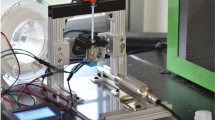Abstract
High-frequency induction is an efficient way to heat mold surface by non-contact electromagnetic induction. It has been recently applied to injection molding because of its capability to heat and cool mold surface rapidly. This study applies high-frequency induction heating to eliminate weldlines in an injection-molded plastic part. To eliminate or reduce weldlines, the mold temperature at the corresponding weld locations should be maintained higher than the glass transition temperature of the resin material. Through 3 s of induction heating, the maximum temperature of 143 °C is obtained on the mold surface around the elliptic coil, while the temperature of the mold plate is lower than 60 °C. An injection molding experiment is then performed with the aid of induction heating, and the effect of induction heating conditions on the surface appearance of the weldline is investigated. The weldline on the heated region is almost eliminated, from which we can obtain the good surface appearance of the part.
Similar content being viewed by others
References
S. Fellahi, A. Meddad, B. Fisa, and B. D. Favis, Weldlines in injection-molded parts: A review, Adv. Polym. Technol., 14 (1995) 169–195.
K. Tomari, S. Tonogai, T. Harada, H. Hamada, K. Lee, T. Morii, and Z. Maekawa, The V-notch at weld lines in polystylene injection molding, Polym. Eng. Sci., 30 (1990) 931–936.
A. Brahimi, A. Ait-Kadi, and A. Ajji, Weld line and mechanical properties of injection molded Polyethylene/Polystylene/Copolymer blends, Polym. Eng. Sci., 34 (1994) 1202–1210.
R. Selden, Effect of processing on weld line strength in five thermoplastics, Polym. Eng. Sci., 37 (1997) 205–218.
R. P. Koster, Importance of injection molding parameters for mechanical performance of cold flow weld lines, J. Inject. Mold. Tech., 3 (1999) 154–158.
G. Tosello, A. Gava, H. N. Hansen, G. Lucchetta, and F. Marinello, Characterization and analysis of weld lines on micro-injection moulded parts using atomic force microscopy (AFM), Wear, 266 (2009) 534–538.
D. Yao, T. E. Kimerling, and B. Kim, High-frequency proximity heating for injection molding applications, Polym. Eng. Sci., 46 (2006) 938–945.
S. C. Chen, W. R. Jong, and J. A. Chang, Dynamic mold surface temperature control using induction heating and its effects on the surface appearance on weld line, J. Appl. Polym. Sci., 101 (2006) 1174–1180.
S. Kim, C. S. Shiau, B. Kim, and D. Yao, Injection molding nanoscale features with the aid of induction heating, Polym. Plast. Tech. Eng., 46 (2007) 1031–1037.
K. Park, S. Choi, S. J. Lee, and Y. S. Kim, Injection molding for a ultra thin-wall part using induction heating, Trans. J. Kor. Soc. Mech. Engng. (A), 31 (2007) 594–600.
K. Park, A study on flow simulation and deformation analysis for injection-molded plastics parts using solid elements, Polym. Plast. Tech. Eng., 43 (2004) 1569–1585.
Z. Z. Li, K. S. Heo, and S. Y. Seol, Time-dependent optimal heater control in thermoforming preheating using dual optimization step, Int. J. Prec. Eng. Manuf., 9 (2008) 51–57.
Y. J. Kim and C. H. Choi, A study on life estimation of hot forging die, Int. J. Prec. Eng. Manuf., 10 (2009) 105–114.
Author information
Authors and Affiliations
Corresponding author
Additional information
Keun Park received his B.S. and M.S. degrees in Precision Engineering and Mechatronics from the Korea Advanced Institute of Science and Technology (KAIST), Korea, in 1992 and 1994, respectively. He then received his Ph.D. degree in Mechanical Engineering from KAIST in 1999. Dr. Park is currently an Associate Professor at the School of Mechanical Design and Automation Engineering at Seoul National University of Technology, Korea. His research interests include numerical analysis of material forming processes, rapid mold heating, and micro-fabrication of plastic parts.
Rights and permissions
About this article
Cite this article
Park, K., Sohn, DH. & Cho, KH. Eliminating weldlines of an injection-molded part with the aid of high-frequency induction heating. J Mech Sci Technol 24, 149–152 (2010). https://doi.org/10.1007/s12206-009-1127-4
Received:
Revised:
Accepted:
Published:
Issue Date:
DOI: https://doi.org/10.1007/s12206-009-1127-4




